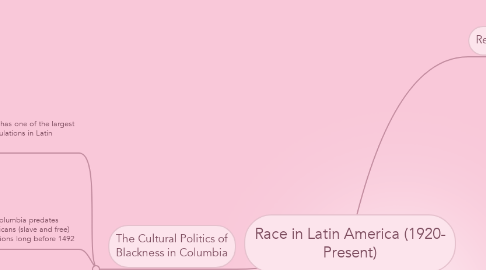
1. The Cultural Politics of Blackness in Columbia
1.1. Columbia has one of the largest black populations in Latin America
1.1.1. Black slaves were referred to by their owners as "Negros"; Free blacks were referred to as "Libres", meaning free- this term is still being used today
1.1.1.1. Some people, during the movements in the 1970's, began using the word "negro in a completely different manner; came to symbolize black solidarity
1.2. Blackness as a concept in Columbia predates Spanish conquest; black Africans (slave and free) were part of Iberian populations long before 1492
1.2.1. In the 1970's Columbian youth began identifying vigorously as blacks; were a small urban intellectual elite of university students and graduates
1.2.1.1. Organizations such as the Cimarron and Smith Cordoba's organization were leaders in this movement
1.2.1.1.1. Ultimately, both organizations had a limited impact; never involved those who were classified or classified themselves as blacks
1.3. Indigenous identity was institutionalized, while Black identity was not
1.3.1. This notion has defined the possibilities of black and indigenous mobilization
1.3.1.1. A struggle over cultural politics ensues, and the result is increased black mobilization and the declaration of law 70
1.3.1.1.1. Law 70 was set in place to recognize the right of Black Columbians to collectively own and occupy their ancestral lands
1.4. The weakness of the ethnic alliance between those organizing around indianness and around blackness was highlighted during the deliberations of the constituent assembly
1.4.1. A document was produced by Lorenzo Muelas with an M-19 delegate Orlando Fals Borda; did not mention blacks at all, restricted its proposals to indigenous people and ethnic groups
2. Re-thinking Race in Brazil
2.1. May 13, 1988- The 100th anniversary of the abolition of slavery in Brazil; many Afro-Brazilians protested the "farce of abolition"
2.1.1. Sentiment of racial prejudice still lingered in the minds of Afro-Brazilians; suggests that the physical chains of Afro-Brazilian slaves had were replaced with metaphorical ones
2.2. The main theories of race in Brazil were critically reviewed in the light of contemporary politics
2.2.1. Brazilian scholar Florestan Fernandes understood race as a problem; solution is integration.
2.2.1.1. Integration a new stage to be achieved in Braz. develpoment; will be that racial conflict is not an obstacle or diversion from class conflict
2.2.1.1.1. Fernandes believed it may never come to pass unless "Brazilian people exhibited enough political will to transcend the racial dilemma and modernise their social order"
2.2.2. Fernandes understood racial dynamics as "survivals" of a plantation slavocracy in which capitalist social relationships had not yet developed
2.2.2.1. A perspective like this, Howard Winant argues, completely disregards the connection between racial phenomena and post-slavery society
2.3. UNESCO sponsored research set new terms for debate, establishing (not without dispute) a new racial "re-invisionism"
2.3.1. Full of insights into Brazilian Racial Dynamics; also had significant limitations-often reduced race to class
2.3.1.1. Brazilian scholar Thales de Asevedo believed the process of race being subordinated to class was already in progress; could be considered a social fact
2.3.2. Carl Degler and Amuary de Souza said that racial dynamics could persist while still remaining subordinated to class conflicts
2.3.2.1. Viewed miscegenation with whites ("whitening") as the preferred solution to Brazil's racial problems
2.3.3. UNESCO studies constantly practiced reductionism; they viewed race as a manifestation of some other, supposedly more fundamental, social process or relationship
2.3.3.1. Race was interpreted in terms of class
2.3.3.2. Reductionism occurs when the independence and depth of racial phenomena goes unrecognized
2.3.3.2.1. Racial dynamics penetrate the fabric of social life and cultural system at every level; cannot be fully understood as a result
3. Latin America in Asia-Pacific Perspective
3.1. Long and continuous historical connection between large region (Latin American coastline) of first Iberian, and later Latin, America and Asia
3.1.1. Cases of Asians establishing small communities in Mexico at beginning of 17th century; Peruvian of Japanese descent was elected President of Portugal in 1990
3.2. Evelyn Hu-DeHart traces history of relationships between Latin America and societies across the Pacific, especially China
3.2.1. Asian labor migrations were initially tied in with developments in Latin America as part of a larger world economy; result of need for labor in plantation economies once abolition of slaery cut off sources of labor in Atlantic Ocean
3.2.1.1. Migrations contributed to formation of "The Pacific"; encouraged further flows of population
3.2.1.2. "The Spanish-Pacific" was a well established geographic and political entity well before the arrival of North Europeans
3.2.1.2.1. Established continuous link with Asia through trade and some migration across the pacific
3.3. The Spaniards figured out a way to the Orient by sailing westward; Established Manila galleon trade
3.3.1. First Asian Colony appeared in "New Spain" (Latin American coastline) shortly after (around 1635)
3.3.1.1. Shortly after, Spanish barbers in Mexico City complained about tough and excessive competition from Chinese barbers; petitioned to the Viceroy to move the colony to the outskirts of the city
3.3.1.2. The Asian colony left legacies firmly entrenched in Mexican folklore
3.4. The reality of the Spanish-Asian Pacific was renewed by Mexican and Peruvian independence from Spain
3.4.1. International labor migration and population movements from Asia played a pivotal role in this creation
3.4.1.1. Chinese labor initially the most prominent in these population movements at the turn of the 20th century; Japanese labor would come later
3.4.1.2. Peru heavily promoted the importation of Chinese "Coolies" (Contract laborers) to work on sugar plantations; bore similarities to the African slave trade
3.4.1.2.1. Several thousand coolies helped build the Andean railroad in Peru; worked in the offshore guano mines south of Lima
3.4.1.2.2. Escaped coolies and free Chinese were the pioneers who penetrated the Peruvian Amazon; built settlements, introduced trade activities, cultivated a variety of crops, manufactured on a small scale, and brokered communication with the native Amazonian peoples and later European arrivals.
